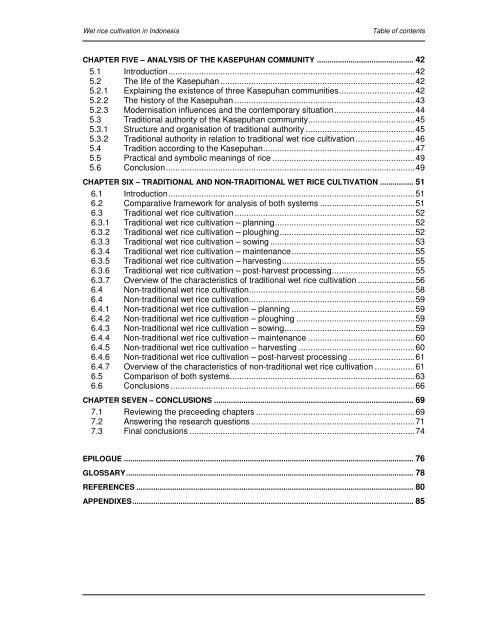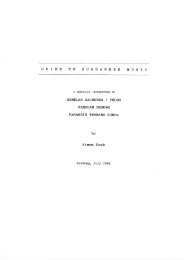Wet rice cultivation in Indonesia - Free EBooks Library
Wet rice cultivation in Indonesia - Free EBooks Library
Wet rice cultivation in Indonesia - Free EBooks Library
Create successful ePaper yourself
Turn your PDF publications into a flip-book with our unique Google optimized e-Paper software.
<strong>Wet</strong> <strong>rice</strong> <strong>cultivation</strong> <strong>in</strong> <strong>Indonesia</strong> Table of contents<br />
CHAPTER FIVE – ANALYSIS OF THE KASEPUHAN COMMUNITY .............................................. 42<br />
5.1 Introduction........................................................................................................42<br />
5.2 The life of the Kasepuhan ..................................................................................42<br />
5.2.1 Expla<strong>in</strong><strong>in</strong>g the existence of three Kasepuhan communities................................42<br />
5.2.2 The history of the Kasepuhan ............................................................................43<br />
5.2.3 Modernisation <strong>in</strong>fluences and the contemporary situation..................................44<br />
5.3 Traditional authority of the Kasepuhan community.............................................45<br />
5.3.1 Structure and organisation of traditional authority ..............................................45<br />
5.3.2 Traditional authority <strong>in</strong> relation to traditional wet <strong>rice</strong> <strong>cultivation</strong>.........................46<br />
5.4 Tradition accord<strong>in</strong>g to the Kasepuhan................................................................47<br />
5.5 Practical and symbolic mean<strong>in</strong>gs of <strong>rice</strong> ............................................................49<br />
5.6 Conclusion.........................................................................................................49<br />
CHAPTER SIX – TRADITIONAL AND NON-TRADITIONAL WET RICE CULTIVATION ................ 51<br />
6.1 Introduction........................................................................................................51<br />
6.2 Comparative framework for analysis of both systems ........................................51<br />
6.3 Traditional wet <strong>rice</strong> <strong>cultivation</strong>............................................................................52<br />
6.3.1 Traditional wet <strong>rice</strong> <strong>cultivation</strong> – plann<strong>in</strong>g...........................................................52<br />
6.3.2 Traditional wet <strong>rice</strong> <strong>cultivation</strong> – plough<strong>in</strong>g.........................................................52<br />
6.3.3 Traditional wet <strong>rice</strong> <strong>cultivation</strong> – sow<strong>in</strong>g .............................................................53<br />
6.3.4 Traditional wet <strong>rice</strong> <strong>cultivation</strong> – ma<strong>in</strong>tenance....................................................55<br />
6.3.5 Traditional wet <strong>rice</strong> <strong>cultivation</strong> – harvest<strong>in</strong>g........................................................55<br />
6.3.6 Traditional wet <strong>rice</strong> <strong>cultivation</strong> – post-harvest process<strong>in</strong>g...................................55<br />
6.3.7 Overview of the characteristics of traditional wet <strong>rice</strong> <strong>cultivation</strong> ........................56<br />
6.4 Non-traditional wet <strong>rice</strong> <strong>cultivation</strong>......................................................................58<br />
6.4 Non-traditional wet <strong>rice</strong> <strong>cultivation</strong>......................................................................59<br />
6.4.1 Non-traditional wet <strong>rice</strong> <strong>cultivation</strong> – plann<strong>in</strong>g ....................................................59<br />
6.4.2 Non-traditional wet <strong>rice</strong> <strong>cultivation</strong> – plough<strong>in</strong>g ..................................................59<br />
6.4.3 Non-traditional wet <strong>rice</strong> <strong>cultivation</strong> – sow<strong>in</strong>g.......................................................59<br />
6.4.4 Non-traditional wet <strong>rice</strong> <strong>cultivation</strong> – ma<strong>in</strong>tenance .............................................60<br />
6.4.5 Non-traditional wet <strong>rice</strong> <strong>cultivation</strong> – harvest<strong>in</strong>g .................................................60<br />
6.4.6 Non-traditional wet <strong>rice</strong> <strong>cultivation</strong> – post-harvest process<strong>in</strong>g ............................61<br />
6.4.7 Overview of the characteristics of non-traditional wet <strong>rice</strong> <strong>cultivation</strong> .................61<br />
6.5 Comparison of both systems..............................................................................63<br />
6.6 Conclusions .......................................................................................................66<br />
CHAPTER SEVEN – CONCLUSIONS ............................................................................................... 69<br />
7.1 Review<strong>in</strong>g the preceed<strong>in</strong>g chapters ...................................................................69<br />
7.2 Answer<strong>in</strong>g the research questions .....................................................................71<br />
7.3 F<strong>in</strong>al conclusions ...............................................................................................74<br />
EPILOGUE .......................................................................................................................................... 76<br />
GLOSSARY......................................................................................................................................... 78<br />
REFERENCES .................................................................................................................................... 80<br />
APPENDIXES...................................................................................................................................... 85








